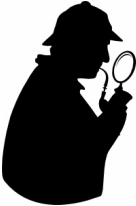
Believe it or not, many of the characteristics stereotypically associated with Sherlock Holmes were not actually significant elements in most—or even any—of the 60 stories written by Sir Arthur Conan Doyle about the now-iconic fictional detective. Holmes’ magnifying glass, for example, appeared occasionally in the novels and short stories, while the distinctive, curved calabash pipe did not feature at all, but became a part of the Holmes persona over time, as people interpreted the character on stage, in films, and in illustrations. The instantly-recognizable double-brimmed deerstalker hat, while not mentioned by name in the Sherlock Holmes canon, was represented in the original commissioned illustrations that accompanied the first publications of Conan Doyle’s stories in The Strand Magazine in the late 19th century. Since then, there have been numerous adaptations and reinterpretations of the famous sleuth and his adventures with trusted sidekick, Dr. Watson. Many of these adaptations, however, were produced only with the blessing of (and payment of licensing fees to) the late British author’s estate, even though only a handful of the stories from the Sherlock Holmes catalog of work were still under copyright.
California-based lawyer and author Leslie Klinger—who, according to his website, is “one of the world's foremost authorities on Sherlock Holmes”—agreed to the Conan Doyle estate’s demand of purchasing a $5,000 copyright license before publishing his 2011 anthology entitled “Study in Sherlock: Stories Inspired by the Sherlock Holmes Canon.” When the estate learned that Klinger was working on a sequel a few years later, they demanded his publisher halt publication until he would agree to obtain another license. Instead of capitulating, Klinger sued the estate on the grounds that his work was only drawing from stories that were already in the public domain under copyright law, and thus, did not require a license for use. Under US law, works published before 1923 are now considered to be in the public domain; this includes the 50 Sherlock Holmes stories published between 1887 and 1922. But the 10 most recently-published stories are still under copyright protection, since they were published after 1923. The Conan Doyle estate argued that the dynamic development of the two main characters was not fully complete until those final 10 stories were published, and hence, Holmes and Watson should not yet be freely used in the public domain, as elements of the characters themselves were still copyrighted.
A federal appeals court in Chicago disagreed with the Conan Doyle estate and the Conan Doyle estate has petitioned the Supreme Court to review this case. If this court decision stands, the enigmatic residents of the fictitious 221B Baker Street will finally enter the public domain in their entirety and may be used freely in new creative works without having to seek permission from the author’s descendants.
California-based lawyer and author Leslie Klinger—who, according to his website, is “one of the world's foremost authorities on Sherlock Holmes”—agreed to the Conan Doyle estate’s demand of purchasing a $5,000 copyright license before publishing his 2011 anthology entitled “Study in Sherlock: Stories Inspired by the Sherlock Holmes Canon.” When the estate learned that Klinger was working on a sequel a few years later, they demanded his publisher halt publication until he would agree to obtain another license. Instead of capitulating, Klinger sued the estate on the grounds that his work was only drawing from stories that were already in the public domain under copyright law, and thus, did not require a license for use. Under US law, works published before 1923 are now considered to be in the public domain; this includes the 50 Sherlock Holmes stories published between 1887 and 1922. But the 10 most recently-published stories are still under copyright protection, since they were published after 1923. The Conan Doyle estate argued that the dynamic development of the two main characters was not fully complete until those final 10 stories were published, and hence, Holmes and Watson should not yet be freely used in the public domain, as elements of the characters themselves were still copyrighted.
A federal appeals court in Chicago disagreed with the Conan Doyle estate and the Conan Doyle estate has petitioned the Supreme Court to review this case. If this court decision stands, the enigmatic residents of the fictitious 221B Baker Street will finally enter the public domain in their entirety and may be used freely in new creative works without having to seek permission from the author’s descendants.
